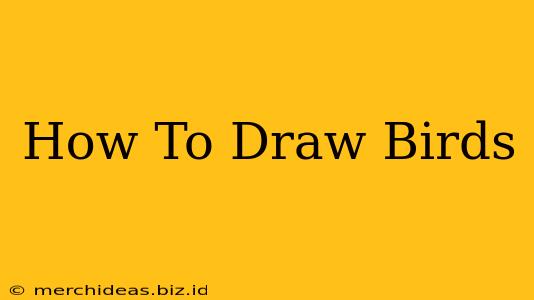So you want to learn how to draw birds? It's a rewarding pursuit, offering a chance to capture the beauty and grace of these fascinating creatures. Whether you're a complete beginner or have some drawing experience, this guide will equip you with the skills and knowledge to create stunning bird illustrations. Let's take flight!
Understanding Bird Anatomy: The Foundation of Your Artwork
Before you even pick up your pencil, understanding basic bird anatomy is crucial. This isn't about becoming a veterinarian, but rather grasping the key shapes and proportions that define a bird's form.
Key Anatomical Features to Focus On:
- The Body: Think of a bird's body as a streamlined teardrop or oval shape. This central form will act as the base for all other elements.
- The Head: The head size varies greatly depending on the species, but it generally connects smoothly to the body. Observe the beak shape – it's a distinctive feature.
- The Wings: Wings are complex structures, but you can simplify them initially as slightly curved teardrop shapes. Consider the position of the wings – are they folded, outstretched, or in flight?
- The Legs and Feet: Bird legs are often long and thin, ending in feet adapted to their environment (perching, wading, grasping, etc.). Pay close attention to the position and number of toes.
- The Tail: The tail's length and shape vary widely across bird species. It provides balance and steering in flight.
Essential Materials for Bird Drawing
Having the right tools makes the process smoother and more enjoyable. Here's what you'll need:
- Pencils: A variety of pencils (H2, HB, 2B, 4B) will allow you to create different line weights and shading effects.
- Eraser: A kneaded eraser is ideal for bird drawing as it can lift graphite without damaging the paper.
- Drawing Paper: Choose a smooth drawing paper that won't snag your pencils.
- Sharpener: Keep your pencils sharp for precise lines and details.
- Reference Images: Find high-quality photographs or illustrations of the bird you're drawing.
Step-by-Step Guide to Drawing a Bird
Let's walk through drawing a simple bird. We'll use a robin as an example, but the principles apply to many other species.
Step 1: Sketching the Basic Shapes
Start by lightly sketching the basic teardrop shape for the body. Add the circle for the head, and then lightly outline the wings and tail using simple shapes.
Step 2: Refining the Forms
Refine your initial shapes, paying attention to the proportions of the bird. Add details to the head, such as the beak and eye. Begin to suggest the feathers with light, feathery strokes.
Step 3: Adding Details and Shading
Add details like the legs and feet. Observe how the light falls on the bird and use shading to create depth and volume. Darker areas will show where the light doesn't directly hit.
Step 4: Finalizing Your Drawing
Once you're happy with your shading and details, you can darken your lines to create a more finished look. Erase any unnecessary guidelines.
Practice Makes Perfect
Drawing birds takes practice and patience. Don't get discouraged if your first attempts aren't perfect. The more you draw, the better you'll become at capturing the essence of these magnificent creatures. Experiment with different bird species and drawing techniques.
Beyond the Basics: Exploring Different Styles
Once you've mastered the fundamentals, you can explore different artistic styles:
- Realistic Bird Drawing: Focus on accurate anatomical details and lifelike rendering.
- Cartoon Bird Drawing: Simplify shapes and exaggerate features for a playful effect.
- Watercolor Bird Drawing: Add vibrant colors and soft washes to your illustrations.
Remember: Observe birds in your environment. Use photographs as references, but always try to capture the bird's unique personality and movement. Happy drawing!
